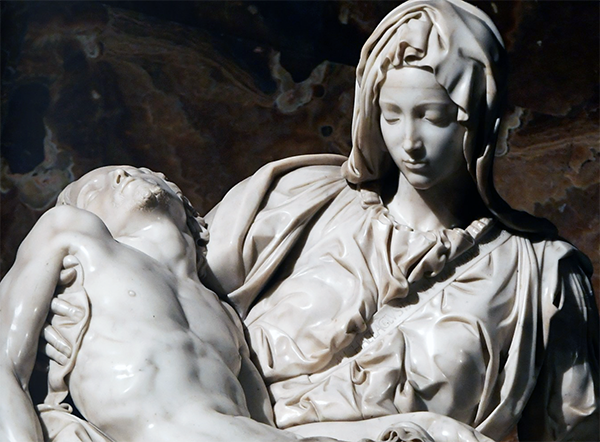Art Essay of the Month: Pietà (1497–1499) by Michelangelo (1475–1564)
- AMY GIULIANO
When twenty-three year old Michelangelo Buonarroti arrived in Rome to complete his very first public commission, he was provided with a single block of marble, a one-year timeframe, and a sacred theme: the Pietà.
Join the worldwide Magnificat family by subscribing now: Your prayer life will never be the same!

The young artist's rendition confounded expectations and catapulted him into the limelight.
The image of Mary cradling the lifeless Christ fascinated the artist—a devout Third Order Franciscan—throughout his lifetime. He sculpted several interpretations of the subject, including one to grace his own tomb. In that final work, the great master entered the sacred scene, leaving us his self-portrait on the face of Nicodemus.
Michelangelo's youthful Pietà explores sublime paradoxes of our faith with masterful innovation and nuance. It thereby reconnects viewers with the startlingly strange beauty of the Christian mysteries, giving us fodder for a lifetime's worth of meditation.
God-Man
Pietà imagery originated in High Gothic Germany. Stripped of narrative elements related to the lamentation over Christ's body, these images directly confront the viewer with an unsettling scene of concentrated grief. Upending the familiar Virgin and Child trope, antecedents to Michelangelo's Pietà are jarring and violent, underscoring the horror of the crucifixion.
Michelangelo was the first sculptor to eschew this grim approach. Minimising Christ's wounds, the Florentine delineates the corpus with extraordinary delicacy, fashioning its forms in perfect proportion. Having recently rediscovered the art of Greek antiquity, Renaissance artists grasped the Platonic notion that ideal physical beauty is an expression of the divine. As with an ancient statue of a god or goddess, the exterior physical perfection of Christ's body signals transcendent divinity.
Yet, for all its perfection, something is amiss. Muscle and sinew have abandoned their agency; Christ's torso sinks into Mary's supportive grasp. Michelangelo, radically rejecting the proud and powerful bearing of the Greek gods, instead sculpts a vulnerable, supine figure. This marble "stumbling block" would be sheer "foolishness to the Greeks" and their concept of divinity. It preaches Christ crucified, for God's weakness is stronger than human strength (1 Co 1:23-25).
The history of Christian art is—in large part—a series of creative responses to the immense challenge of depicting Jesus. How can one visually capture a man who is fully divine? Michelangelo's audacious attempt resulted in one of history's most compelling portrayals of Christ.
Virgin-Mother
Artists tackling this subject face the difficulty of fitting a man's full-length body across a woman's lap. Avoiding an awkward composition, Michelangelo presents the figures in a stable pyramidal arrangement. The Virgin's head forms the apex while her legs—hidden amidst voluminous drapery—fill out the base. If Mary were to stand up, she would tower over us. Her legs are disproportionately large in order to contain the body of her Son. Michelangelo artfully conceals this fact, and our eyes are easily fooled.
The history of Christian art is in large part a series of creative responses to the immense challenge of depicting Jesus.
Christ's flesh is highly polished and almost totally exposed; he is the shining focal point of the sculptural group. Mary's body, by contrast, is entirely engulfed in shadowy folds. She fades into the darkness of the niche. Seated directly on the hill of Golgotha, she is a Madonna of Humility—a common iconographic type. Humus, the Latin root of humility, means earth, or soil.
By means of Michelangelo's artifice, Mary forms the foundation and backdrop upon which Christ's body is gracefully draped, highlighted, and grounded. Christ has no human father; all his DNA comes from his mother. Her flesh is inextricably linked to his Incarnation, Passion, and Eucharistic presence. The cloaked Virgin is—artistically and theologically—the necessary foundational figure and shrouded, hidden backdrop to Christ's humanity, the fertile soil that is its source. This at last is bone from my bones, and flesh from my flesh; Adam's ecstatic refrain may well have been echoed by the new Eve as she gazed upon her Son.
Eucharist
Mary cradles the fruit of her womb: the incarnate, crucified God. But the Pietà captures more than a historical moment of mourning, poignant as it may be. Michelangelo anticipated the viewer's unfolding interaction with the sculpture and fashioned it accordingly.
Notice that Mary touches Jesus only indirectly—through her garment—as with the humeral veil of a priest. What's more, Christ's body lies imbalanced across her knees, tilted towards the viewer as she offers it with open hand. Commissioned as an altarpiece, the Pietà captures a moment of impending motion—the instant before the body of Christ slips out of Mary's lap onto the altar below. The words of consecration are tacitly reprised: This is my body, given up for you.
Serenity
Michelangelo did not want his Pietà to focus on death, but rather, as it has been said, "to show a religious vision of abandonment and a serene face of the Son of God." A pervading peace emanates from Christ's visage, underscored by the complete relaxation of his inert limbs and neck. We are witnessing the sleep of the new Adam. Saint Augustine reminds us, "Just as from Adam's side in sleep Eve was formed, so from the side of the sleeping Lord, dead in his Passion and pierced with the lance, the sacraments flowed forth by which the Church was formed."
Such serenity incites hope. Even within this sombre scene, we spy an allusion to the stump of Jesse at Christ's heel. Though cut off from the land of the living, Christ will rise, the root shall blossom forth. God's promises are not forgotten.
Self-Abandonment
The artist's signature, "Michelangelo Buonarotti the Florentine was making [this]", uses the imperfect tense and omits the verb's final letter, hinting that the piece is still in the process of being made. It is somehow completed in the contemplation of the viewer.
In its perfection of form and—much more so—in its sacred content, the Pietà unnerves us with exquisite beauty. Christ's face reveals the ecstasy of total self-abandonment, even unto death, for the sake of each individual soul. We are left to behold his gift, to contemplate it, and—by his grace—to respond in kind.
 This is Meaghen Gonzalez, Editor of CERC. I hope you appreciated this piece. We curate these articles especially for believers like you.
This is Meaghen Gonzalez, Editor of CERC. I hope you appreciated this piece. We curate these articles especially for believers like you.
Please show your appreciation by making a $3 donation. CERC is entirely reader supported.

Acknowledgement
 Amy Giuliano. "Art Essay of the Month: Pietà (1497–1499) by Michelangelo (1475–1564)." Magnificat (September 2022).
Amy Giuliano. "Art Essay of the Month: Pietà (1497–1499) by Michelangelo (1475–1564)." Magnificat (September 2022).
Reprinted with permission from Magnificat.
Join the worldwide Magnificat family by subscribing now: Your prayer life will never be the same!
The Author
Amy Giuliano holds degrees in Religion and the Visual Arts from Yale, Theology from the Angelicum in Rome, and Catholic Studies from Seton Hall University. She teaches Art History and Catholic Studies at Sacred Heart University, writes sacred art essays for the Magnificat, and travels the world creating virtual tours of the Church's artistic patrimony.
Copyright © 2022 Magnificat



